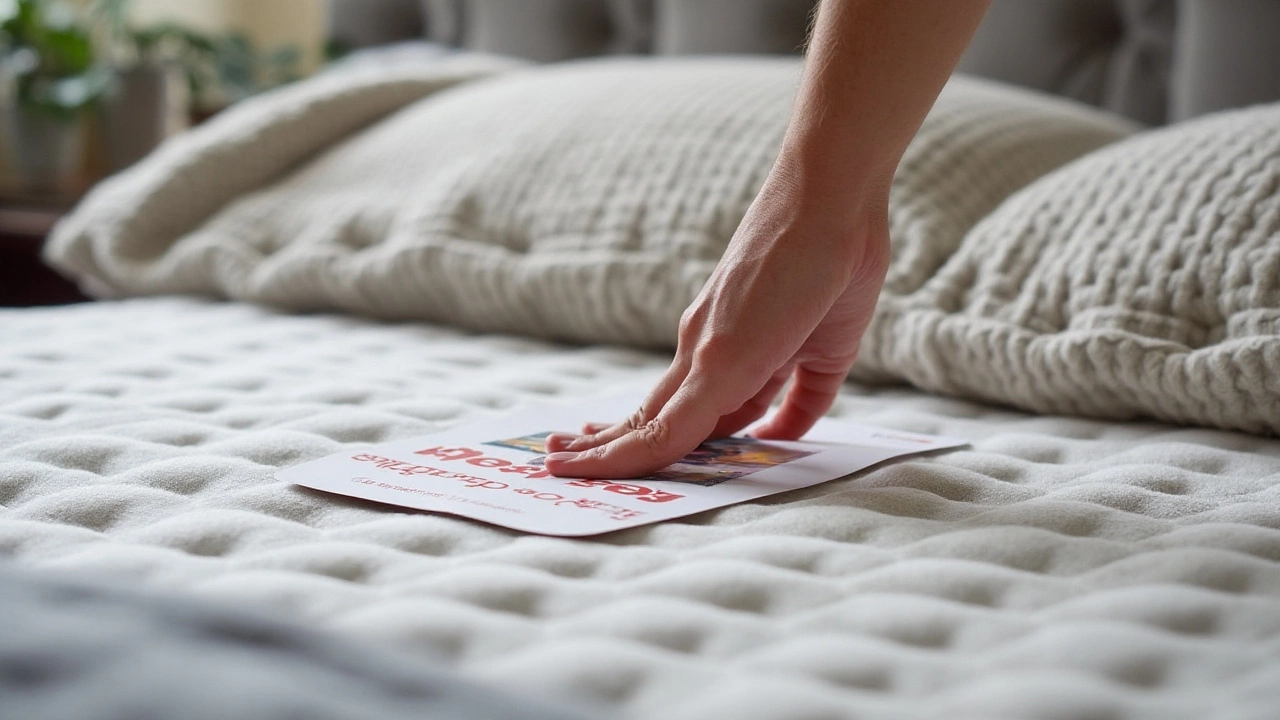Understanding the Bedding-In Period: Essential Tips and Insights

Buying a new mattress is an exciting venture, paving the way for better nights and more rejuvenating mornings. Yet, as straightforward as this purchase might seem, there's a lesser-known phase that follows: the bedding-in period. This isn't just a quirky loophole in the mattress-buying process, but a transitional period that plays a significant role in aligning your sleep comfort to its fullest potential.
During the bedding-in period, both your body and the new mattress embark on a mutual journey of adaptation. This phase ensures that the materials within your mattress soften and contour more accurately to your body's unique shape, ultimately enhancing its overall comfort. So, what exactly happens during this time, and how can you navigate it smoothly? This article unpacks the essentials to ensure you, and your new mattress, get off on the right foot.
- What is the Bedding-In Period?
- Why the Bedding-In Period Matters
- How Long Does It Take?
- Tips for Maximizing Comfort
- When to Consider a Different Option
What is the Bedding-In Period?
The bedding-in period is a vital yet often overlooked phase that occurs after purchasing a new mattress. During this time, both the mattress and your body undergo an adjustment process to create an optimal sleep environment. This period typically lasts from a few weeks to a couple of months, depending on factors like mattress materials and individual preferences. As you spend more nights on your new sleep surface, the materials start to soften and contour to your body, ensuring a more customized support and comfort level.
To understand why the bedding-in period is necessary, it's essential to delve into the nature of modern mattresses. Most new mattresses, especially those crafted from memory foam or latex, are designed to adapt to body heat and pressure. Initially, they might feel different or even uncomfortable, as bones and muscles face a shift from the beat-up old mattress that conformed to their previous sleeping arrangement. Over time, however, the mattress begins to provide the tailored support it was engineered for, and sleepers start to reap the benefits in the form of improved sleep quality and minimized discomfort.
This adjustment phase is not just for the mattress; it's also a learning period for your body. Think of it like wearing in a new pair of shoes. Initially, they might feel snug or stiff, but with consistent wear, they break in and become comfortably familiar. This period of gradual adjustment allows your body to adapt to the new support levels, which can significantly enhance your overall sleep experience. It's interesting to note that sleep comfort may initially feel less than desirable, leading some to believe they've made the wrong mattress choice. But in reality, it's a temporary phase before settling into newfound comfort.
Anecdotal experiences from sleep experts and users often emphasize the patience required during the bedding-in period. As sleep consultant Jane Williams highlights,
"Patience during the initial weeks can reward you with years of restful and rejuvenating sleep. Most mattress returns happen during this phase due to premature conclusions."This period serves as a litmus test for your new mattress, balancing a rich interplay between mattress technology and human physiology.
Finally, consider that the bedding-in period can be influenced by various external factors, such as room temperature and humidity, which can affect how quickly your new mattress adapts to your body. It's key for users to be conscious of personal room climate settings to further facilitate this adjustment process. As the bedding-in period unfolds, marking each week with positive sleep changes can be an encouraging experience for any new mattress owner. Acknowledging this transition period helps set realistic expectations and reduces the possibility of premature dissatisfaction.
Why the Bedding-In Period Matters
The bedding-in period serves as a critical component in ensuring your new sleep environment genuinely enhances your comfort and well-being. During this crucial phase, both the mattress and your body undergo an adaptation process that is vital for optimum comfort and support. When you bring a new mattress home, it isn't just about plopping it down and drifting off into dreamland. The materials within—whether they're composed of memory foam, latex, or traditional springs—require time to adjust. This adjustment is not simply about the materials themselves but also about how they react to your body's unique shape, weight, and sleeping habits. This process can take a bit of time and patience.
A key reason this period matters is that your body itself is also adapting. Imagine switching from shoes with worn-in tread to a brand-new pair; initially, they might feel stiff and somewhat uncomfortable. Your body has grown used to certain pressure points and support structures, and any shift, even a seemingly positive one, can feel foreign until both you and your mattress align with each other. Insufficient patience during this phase can lead to unnecessary frustration or the premature returning of a mattress without fully realizing its potential. Considering stats from the Sleep Foundation, it's noted that proper adaptation to a new mattress can enhance sleep quality by up to 15% within the first few weeks.
Factors Contributing to the Bedding-In Period
Several factors contribute to the significance of the bedding-in period. For starters, the materials in a new mattress are often still in their initial form, and the natural settling process begins only once they experience consistent use. This ensures the materials soften at the right places, helping alleviate pressure points that can cause discomfort or even interrupt sleep. The process also impacts the longevity of the mattress itself, allowing it to better support you over time and maintain its durability.
Moreover, the bedding-in period plays a psychological role too. A smooth transition to a new mattress can coincide with adjustments in sleep patterns and routines, often prompting individuals to focus more on quality sleep and adequate rest. A quote from sleep scientist Dr. Matthew Walker captures this rather aptly:
"A change as fundamental as the surface we sleep on requires our body and mind to recalibrate, emphasizing just how interconnected our habits, psychology, and physical health truly are."
In conclusion, understanding why the bedding-in period matters can ease the process and maximize the benefits of your new investment. Investing a bit of patience and openness to this period not only reassures you but also helps you realize what it truly means to have better sleep. These short weeks of adjustment can, in fact, lead to years of restful, rejuvenated nights.

How Long Does It Take?
The time it takes for a bedding-in period to complete can vary significantly depending on numerous factors. Whether you’re a seasoned sleeper instantly attuned to the rhythm of new mattresses, or someone whose body needs a little more persuasion to relax into unexplored comfort, knowing the typical duration prepares you for what lies ahead. Generally, the bedding-in period can span from a few weeks to even a couple of months. On average, most individuals find that anywhere from 30 to 90 days is a sufficient range for their bodies to adapt to a new sleeping surface.
One important factor that influences the length of the bedding-in period is the type of mattress materials. Memory foam, for instance, tends to evolve with time more gradually. These mattresses often require a longer adaptation period as the foam layers need to fully respond to your body heat and weight, optimizing their support and comfort. On the other hand, spring mattresses generally offer a shorter acclimatization period since the coils have established elasticity that stabilizes faster. During this phase, you might not have the best sleep initially but worry not; patience is key.
"The primary thing to remember about the bedding-in period is that it's a journey, not a sprint. Allow both your physiology and the mattress to form a partnership," said Dr. Michelle Miller, a renowned sleep specialist.
It’s not just about the mattress, though. Your own previous experiences with sleep surfaces will play a role in how quickly you adjust. Factors such as your weight distribution, usual sleep position, and even climate can influence this timeline. If you're accustomed to a firm sleep surface and transition to a plush mattress, brace yourself for a more extended adaptation process. Likewise, switching from a pliant mattress to a sturdier one might surprise your body and prolong adjustment. Maintaining realistic expectations during this time is crucial to embracing the full benefit of your new sleeping aid.
Adjusting to a new mattress might also involve some additional measures, especially if your current bed setup is considerably different from the past. If you're shifting from an old, saggy model to one that's professionally recommended, it might be wise to follow a progressive break-in routine. Try to spend more time lying down during the day. This can significantly ramp up the adjustment because the mattress materials will get a better chance to contour effectively to your natural form, making those night hours eventually more inviting.
Patience can truly redefine your sleep comfort. In certain circumstances, employing specific techniques might persuade the mattress to hasten its integration into your sleep life. Unwrapping the mattress promptly upon delivery, ensuring good air circulation around it, and even gentle rolling or bouncing can help loosen up tightly packed mattress materials. Giving the mattress a fair trial is critical; this means allocating sufficient time for the quality of your sleep to harmoniously align with your newly acquired sleep foundation.
So, how long does it take? It’s both a matter of mattress material and individual physiology. It's a phase where blending your patience with a little diligence can yield a perfect synergy that rewards one with blissful nights ahead. As with most things in life, adaptability is the hallmark of smooth transitions.
Tips for Maximizing Comfort
Embarking on the bedding-in journey with your new mattress involves more than just placing it on the bed and laying your head down at night. It requires a degree of patience and several proactive steps to ensure you're maximizing comfort during this period. One of the most essential things is to give your mattress time to breathe and settle once it's unpackaged. Mattresses, particularly those made with foam layers, can have a distinct smell due to the materials used, and this odor diminishes as they air out. Placing it in a well-ventilated space for the first several hours—or even a day—can help in releasing any manufacturing-made scents.
Another critical aspect of navigating the bedding-in period is adjusting your sleep environment to suit your new mattress. Ensure that your bed frame or base offers the right support. This is a vital foundation for your mattress to perform optimally. Whether it's a solid platform or a slatted frame, the right kind of support enhances comfort and durability. Using an appropriate mattress protector and bedding is also key, not only for hygiene but in preserving the mattress's feel and increasing its longevity. Opt for breathable natural fabrics that work with your mattress's design, facilitating temperature regulation and ensuring your comfort throughout the night.
Consistent rotation of the mattress can be beneficial too. Consider flipping or rotating your mattress every few weeks during the first three months to ensure even wear and to help it contour to your body's unique shape. This simple act can do wonders for spreading out the comfort evenly across the surface. Be mindful of any sensations or discomfort you might feel and understand that slight adjustments are normal as your body gets used to the new feel. If you're used to a firmer mattress and have switched to something softer—or vice versa—give your muscles and bones a good amount of time to acclimatize.
As sleep expert Chris Winter states, 'Your body is like a musical instrument. A new mattress can initially feel like playing with new strings, but with time and adjustment, the melody becomes familiar and soothing.'
Remember that part of maximizing the comfort of your new mattress involves listening to your body and being aware of how you respond to the changes. Adjust your sleeping positions if necessary and consider using supplemental support like specialized pillows to enhance your alignment and comfort levels. Don't hesitate to experiment with the number and type of pillows you use, as they play a significant role in complementing your mattress choice and achieving the perfect balance.
Sleep comfort extends beyond just the mattress, and optimizing your bedroom environment will undoubtedly contribute to your overall experience. Control the lighting by minimizing exposure to electronic screens before bedtime, use blinds to block out external light, and ensure the room is at a comfortable temperature. Using soothing aromas like lavender or playing soft music can also help in making the bedding-in period less noticeable, enhancing both the physical and psychological aspects of restful sleep.

When to Consider a Different Option
As you allow your body to adjust during the bedding-in period, patience can often yield the most rewarding results. Yet, there are times when things don't feel quite right, despite giving it all the time and space possible. Knowing when to consider a different option is vital to ensure that you aren't stuck with a mattress that refuses to align with your sleep needs. Generally, you might need to look for alternatives if massive discomfort persists beyond a typical adaptation period, which is usually around 30 to 90 days. This discomfort could manifest in persistent aches or restless nights that affect daily functioning. In such cases, it may be worth revisiting what your mattress promises versus what it delivers, examining its density and support features.
Recognizing your body's responses is crucial. If your body signals any unusual discomfort or pain exacerbation, it might signify a mismatch between your mattress and your physical requirements. Many sleepers who experience chronic discomfort find that it's a sign to reevaluate their decision and explore models that cater better to their specific concerns. You might also run into unique situations where, despite a seemingly perfect mattress, the product and your comfort expectations go off the rails.
"Listen to your back. Comfort without support is like sleep without rest," advises a prominent sleep expert.The essence lies in reflecting on whether the misalignment is temporary or persists as a recurring theme.
In some cases, a persistent odor from certain mattress materials might influence your decision. Although this off-gassing odor is typically temporary, lasting odors could signal quality concerns and might just be reason enough to consider alternatives. Additionally, read the fine print considering the policy and warranty of your mattress purchase. Many companies provide trial periods or returns, which you should leverage wisely. If hitting those cut-off points with dissatisfaction, don't hesitate to reach out to customer support. They are usually willing to offer assistance or even a replacement.
During the decision phase, it's valuable to seek guidance from sleep experts or check customer reviews for real-life testimonies, highlighting similar experiences and resolutions. Online forums can often provide candid anecdotes that might resonate with your situation, offering hope in the form of tried-and-true strategies or alternatives. Embrace the insights of other satisfied users guided by similar conundrums. This exploration can form the foundation for making a more informed decision moving forward. If the quest for comfort feels overly challenging, it might just be time to consider whether the bedding-in period hiccups signal a need to explore new avenues and options, supporting a far superior sleep journey.